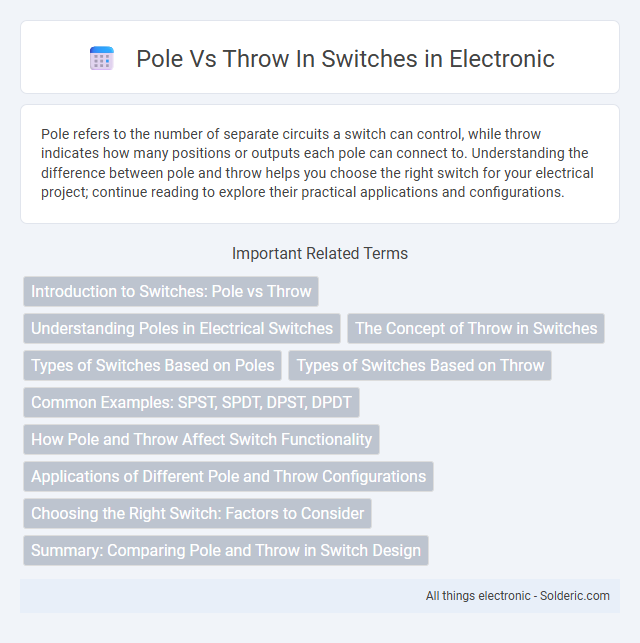Pole refers to the number of separate circuits a switch can control, while throw indicates how many positions or outputs each pole can connect to. Understanding the difference between pole and throw helps you choose the right switch for your electrical project; continue reading to explore their practical applications and configurations.
Comparison Table
| Feature | Pole (Switch) | Throw (Switch) |
|---|---|---|
| Definition | Number of separate circuits controlled by the switch | Number of positions or contacts each pole can connect to |
| Function | Controls multiple independent circuits | Determines the selectable paths for current flow in each pole |
| Example | Single Pole, Double Throw (SPDT): 1 pole | Single Pole, Double Throw (SPDT): 2 throws |
| Application | Used to switch separate circuits on or off | Used to select between two or more circuit outputs or inputs |
| Impact on switch complexity | More poles increase ability to control multiple circuits | More throws increase number of circuit paths per pole |
Introduction to Switches: Pole vs Throw
A switch's pole denotes the number of separate circuits it can control simultaneously, while the throw indicates the number of positions or output contacts each pole can connect to. Single-pole switches manage one circuit, whereas double-pole switches handle two circuits independently. Single-throw switches connect to only one output, and double-throw switches toggle between two outputs, impacting circuit configuration and functionality.
Understanding Poles in Electrical Switches
Poles in electrical switches refer to the number of separate circuits the switch can control simultaneously, with each pole representing an independent path for current flow. A single-pole switch controls one circuit, whereas double-pole switches control two circuits, often used in 240V applications. Understanding poles helps you select the right switch to safely manage multiple circuits or devices in your electrical system.
The Concept of Throw in Switches
The concept of throw in switches defines the number of output circuits a switch can connect to its input, typically classified as single-throw or double-throw. A single-throw switch connects one input to one output, while a double-throw switch toggles the input between two different outputs, enabling circuit selection or direction control. Understanding throw is essential for designing circuits requiring specific signal routing or operational modes.
Types of Switches Based on Poles
Switches based on poles are categorized by the number of separate circuits they control, such as single-pole (SP), double-pole (DP), triple-pole (TP), and four-pole (4P) switches. Single-pole switches control one circuit, while double-pole switches manage two circuits simultaneously with a single toggle. Multi-pole switches are essential in applications requiring simultaneous control of multiple circuits, including industrial machinery and complex electrical systems.
Types of Switches Based on Throw
Switches are categorized based on the number of throws, which indicates how many positions the switch can connect to a single input terminal. Single Throw (ST) switches have one output terminal and are used for simple ON/OFF operations, while Double Throw (DT) switches allow toggling between two output terminals, enabling circuit rerouting or device selection. Multi-Throw switches extend this concept with three or more outputs, supporting complex control circuits in applications such as audio equipment, signal routing, and multi-speed fans.
Common Examples: SPST, SPDT, DPST, DPDT
Switch poles refer to the number of separate circuits controlled by a switch, while throws indicate the number of positions each pole can connect to. Common examples include SPST (Single Pole Single Throw), which controls one circuit with an on/off function, SPDT (Single Pole Double Throw) that connects one input to one of two outputs, DPST (Double Pole Single Throw) controlling two independent circuits simultaneously with an on/off action, and DPDT (Double Pole Double Throw) providing two circuits with two possible connection paths, often used for reversing motor directions or selecting between two power sources. Understanding pole and throw configurations is essential for selecting switches that match specific circuit control requirements in electronics and electrical applications.
How Pole and Throw Affect Switch Functionality
Pole and throw define a switch's configuration by specifying the number of circuits controlled (poles) and the number of connection paths per pole (throws). A single-pole, single-throw (SPST) switch controls one circuit with two positions--on or off--while multi-pole, multi-throw switches enable control of multiple circuits or multiple output paths, enhancing versatility. Understanding pole and throw is essential for selecting switches that meet specific electrical requirements, such as isolating circuits or redirecting current flow efficiently.
Applications of Different Pole and Throw Configurations
Single-pole single-throw (SPST) switches are commonly used for basic on/off control in household lighting and simple appliances, offering straightforward switching. Double-pole double-throw (DPDT) switches find applications in reversing motor directions and selecting between two power sources due to their ability to control two separate circuits simultaneously. Four-pole switches are preferred in industrial settings for managing multi-phase power distribution, providing reliable isolation and switching of complex electrical systems.
Choosing the Right Switch: Factors to Consider
Choosing the right switch involves understanding the distinction between poles and throws, where poles represent the number of circuits controlled and throws indicate the number of output positions per pole. Your application's complexity dictates if a single-pole single-throw (SPST) or a more complex double-pole double-throw (DPDT) switch is necessary, ensuring proper control and functionality. Evaluating voltage, current ratings, and switching configurations in relation to your specific circuit needs guarantees optimal performance and safety.
Summary: Comparing Pole and Throw in Switch Design
Pole and throw define key parameters in switch design, where "pole" refers to the number of separate circuits controlled by the switch, and "throw" indicates the number of positions or outputs each pole can connect to. Understanding your switch's pole configuration, such as single-pole or double-pole, alongside its throw capability like single-throw or double-throw, is essential for selecting the right switch for complex electrical designs. Proper comparison of pole and throw specifications ensures reliable performance and functionality tailored to your specific application.
pole vs throw in switches Infographic

 solderic.com
solderic.com